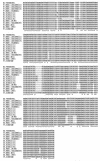Phylogenetic classification of Trichophyton mentagrophytes complex strains based on DNA sequences of nuclear ribosomal internal transcribed spacer 1 regions
- PMID: 9705405
- PMCID: PMC105175
- DOI: 10.1128/JCM.36.9.2629-2633.1998
Phylogenetic classification of Trichophyton mentagrophytes complex strains based on DNA sequences of nuclear ribosomal internal transcribed spacer 1 regions
Erratum in
- J Clin Microbiol 1998 Dec;36(12):3745
Abstract
Using internal transcribed spacer 1 (ITS1) region ribosomal DNA sequences from 37 stock strains and clinical isolates provisionally termed Trichophyton mentagrophytes complex in Japan, we demonstrated the mutual phylogenetic relationships of these strains. Members of this complex were classified into 3 ITS1-homologous groups and 13 ITS1-identical groups by their sequences. ITS1-homologous group I consists of Arthroderma vanbreuseghemii, T. mentagrophytes human isolates, and several strains of T. mentagrophytes animal isolates. Five strains of Arthroderma simii form a cluster comprising ITS1-homologous group II. The Americano-European and African races of Arthroderma benhamiae, T. mentagrophytes var. erinacei, and one strain of a T. mentagrophytes animal isolate constitute ITS1-homologous group III. According to the phylogenetic tree constructed with Trichophyton rubrum as an outgroup, ITS1-homologous groups I and II comprised a monophyletic cluster and ITS1-homologous group III constituted another cluster which was rather distant from the others in the complex. This system was applicable to the phylogenetic analysis of closely related strains. Using this technique, human and animal isolates of T. mentagrophytes were also clearly distinguishable from each other.
Figures



References
-
- Ajello L, Cheng S-L. The perfect state of Trichophyton mentagrophytes. Sabouraudia. 1967;5:230–234. - PubMed
-
- Berbee M L, Yoshimura A, Sugiyama J, Taylor J W. Is Penicillium monophyletic? An evaluation of phylogeny in the family Trichocomaceae from 18S, 5.8S and ITS ribosomal DNA sequence data. Mycologia. 1995;87:210–222.
-
- Carbone I, Kohn L M. Ribosomal DNA sequence divergence within internal transcribed spacer 1 of the Sclerotiniaceae. Mycologia. 1993;85:415–427.
-
- Davidson F D, Mackenzie D W R, Owen R J. Deoxyribonucleic acid base compositions of dermatophytes. J Gen Microbiol. 1980;118:465–470. - PubMed
Publication types
MeSH terms
Substances
Associated data
- Actions
- Actions
- Actions
- Actions
- Actions
- Actions
- Actions
- Actions
- Actions
- Actions
- Actions
- Actions
- Actions
- Actions
LinkOut - more resources
Full Text Sources
Other Literature Sources
Medical

